

High-pressure cleaning for precise debarking of logs is an innovative process widely used in wood processing, log construction, and the production of natural wood products. Instead of relying on mechanical or manual methods, the high-pressure water jet enables uniform, gentle, and efficient removal of tree bark.
Unlike peeling tools or bark mills, which operate through direct material contact and may leave marks or damage, high-pressure debarking is completely contactless. The water jet removes the bark at high velocity without damaging the wood surface – ideal for high-quality woodworking.
Rotary nozzles create a circular, rotating high-pressure jet that removes bark not just at a single point, but evenly across the surface. The resulting shear action precisely separates the bark from the underlying sapwood – particularly effective for thick-barked species.
Professional debarking requires significantly higher pressures than conventional cleaning – typically between 350 and 500 bar. The water flow per minute must also be high enough to flush away loosened bark effectively. The exact settings depend on wood species, log diameter, and moisture content.
Hardwoods such as oak or beech generally require higher pressure than softer species like spruce or pine. Moisture content also matters: freshly cut wood is usually easier to debark because the bark remains elastic and less firmly attached.
Incorrect use – such as too little distance, the wrong angle, or excessive exposure time – can damage the wood. Cracks, roughening, or fiber lifting in the sapwood are common errors that can be avoided through precise control and trained operation.
Operator expertise is a decisive success factor. Only those who correctly judge distance, angle, and movement speed will achieve a consistent result. Specialized training in high-pressure debarking is recommended, particularly for forestry operations, sawmills, or timber construction companies.
Stationary systems are ideal for facilities with fixed operations, such as sawmills. Mobile high-pressure systems, on the other hand, are well suited for forestry or on-site applications where flexibility and quick deployment are required.
The choice of drive depends on the worksite, power availability, and required output.
Unlike grinding or milling, the water jet preserves the wood’s natural grain and strength. The result is both functional and visually appealing – especially for exposed timber applications.
Targeted removal of bark down to the sapwood without damaging the underlying heartwood is a key quality feature. This is essential in log house construction or natural wood projects, where both appearance and stability matter.
The technology is adaptable – suitable for both small and large diameters, as well as for fresh or stored wood. This makes the process versatile across different applications and wood species.
| Term | Definition |
| High-Pressure Cleaner | Device that uses high-pressure water for cleaning |
| Rotary Nozzle | Nozzle with a rotating jet pattern for even surface treatment |
| Working Pressure | Pressure at the nozzle outlet, determining cleaning power |
| Sapwood | Outer, living part of wood responsible for water and nutrient transport |
| Heartwood | Inner, dead part of the tree with high density and stability |
High-pressure cleaning for debarking logs is a precise, resource-efficient, and flexible method proven in both industry and forestry. Success depends on the right equipment, trained personnel, and a technique adapted to the specific wood. This approach achieves optimal quality while preserving material integrity.
1. Is high-pressure debarking possible on hardwoods?
Yes, but it requires higher pressure and precise control, as hardwoods such as oak or ash have thicker, tougher bark. A stronger rotary nozzle with high working pressure can be used effectively – with care to avoid damaging the sapwood.
2. What wood moisture level is ideal for high-pressure debarking?
Fresh, moist wood is easier to debark since the bark is still elastic and less tightly bonded to the sapwood. Drier wood increases resistance – higher pressure or longer exposure may be required.
3. How long does it take to debark a log using high-pressure technology?
This depends on length, diameter, bark thickness, and wood type. An experienced operator can debark a 4–5 meter log in just a few minutes – assuming proper pressure, flow, and nozzle setup.
4. Is the process suitable for later surface treatment?
Yes. Since high-pressure debarking does not roughen or damage the wood, the surface remains ideal for further processing such as sanding, oiling, or staining – perfect for decorative or structural timber applications.
5. What safety measures apply to high-pressure debarking?
Due to the high working pressure, safety goggles, face shield, gloves, hearing protection, and safety footwear are mandatory. The work area should also be cordoned off and protected from water spray.
6. Is a mobile system worth it compared to a stationary one?
For small businesses, forestry operations, or flexible sites, mobile systems are advantageous. Stationary systems are most cost-effective for large-scale operations with continuous throughput, such as sawmills or timber processing centers.
| Method | Advantages | Disadvantages | Typical Applications |
| High-Pressure Debarking | – Gentle on wood structure– No thermal stress– Precise control | – High water consumption– Requires expertise– Safety risks | Log house construction, decorative timber, natural wood processing |
| Mechanical Debarking (Milling) | – Fast for mass processing– Low water use | – High material wear– Risk of wood damage | Industry, large sawmills |
| Manual Peeling | – Highly controlled– No machinery required | – Time-consuming– Physically demanding | Custom pieces, artisanal woodwork |
| Thermal Debarking | – Hygienic– Enables pest control | – Risk of charring– Suitable only for specific wood types | Pallet industry, export preparation |